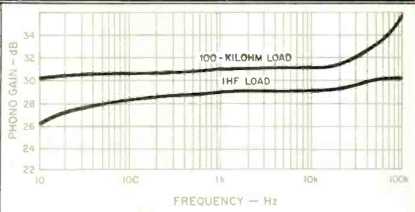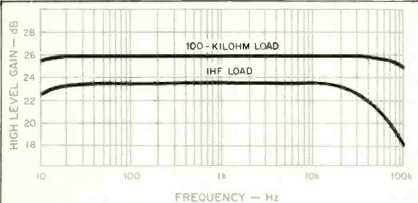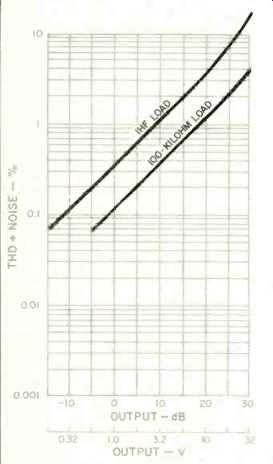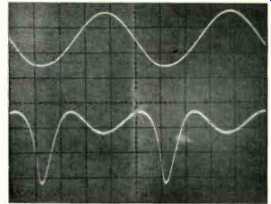
Manufacturer's Specifications:
Frequency Response: 2 Hz to 100 kHz, +0,-1 dB.
Maximum Output: 55 V at 1% THD into 100 kilohms.
THD: 0.2% at 2 V into a 50-kilohm load.
Phono Input Sensitivity: 0.45 mV for 0.5 V output at 1 kHz.
Phono Input Overload: 1.2 V rms at 1 kHz.
Phono Input Impedance: 47 kilohms shunted by 100 pF.
Phono-Section Gain: 30 dB at 1 kHz.
S/N Ratio: 70 dB, IHF A-weighted, for 10-mV signal at phono inputs.
High-Level Sensitivity: 16 mV for 0.5 V output.
Slew Rate: 25 V per S.
Overall Gain: 60 dB. Weight: 9 1/2 lbs. (4.3 kg).
Price: $449.00.
Company Address: 1266 Leigh Ave., San Jose, Cal. 95126.
The Modulus is a low-cost, three-tube, vacuum-tube preamplifier built with special capacitors, a no-feedback line section, and remote power supply. These features underscore the unit's design goals: A simple circuit topology, sonic purity, and a suggested retail price under $450. The assembled and tested Modulus has evolved from the company's earlier, inexpensive kit model, the Mini-Mite I, and offers higher gain and a rack-mount panel. For the determined audiophile in search of the best conics, the Modulus could easily be the lowest-cost component in an "ultimate" system.
Moderate cost is achieved mainly through simplicity of circuitry and operating controls, a goal in itself for certain audiophiles. The Modulus has only one phono, one high-level and one tape input. Front-panel controls are limited to two large, black volume controls, one for each channel, and four pushbutton switches for "Power," "Phono/Tuner Select," "Source/Tape Select," and "Play/Mute" (a useful function, with separate volume controls). External switching would be necessary if one were to use more than one high-level source, such as a CD player and a tuner. The three 6DJ8 vacuum tubes comprise the Modulus's only active circuit devices in the audio path, further emphasizing its simplicity.
The preamp has two sections, the audio control module and a small, cubical, remote transformer unit with a 28-inch, non-detachable, four-conductor cord. The separation protects the unit's phono circuitry from transformer-induced hum. The control unit's aluminum, U-shaped chassis has an interlocking, U-shaped cover with ventilation slots to promote tube cooling. The cover is held on by four machine screws and threaded inserts. Although the sharp-edged, carefully milled 19-inch front panel is rack-mount length, it has a nonstandard 3-inch height. The Modulus's single, epoxy-glass p.c. board is well supported from the chassis bottom by eight threaded standoffs. Six pairs of input and output phono jacks (tape, tuner, and phono inputs, tape out and two pairs of main outputs) are in a line along the board's rear edge and emerge through matching holes in the rear panel. The circuit board has double-sided traces and component-designator silk-screening. Assembly quality and soldering is excellent, with no flux remaining on the board.
The quality of circuit-board components is high. Parts include Resista metal film resistors and Wonder Caps, well known to audiophiles. Some of the film capacitors paralleling electrolytics appear to have been afterthoughts, since there are no pads for them on the p.c. board. Each volume control is actually a dual-element (i.e., stereo) control, with only one section being used. Low-capacitance shielded cables connect these dual volume pots to the circuit board, but the shields, curiously, have been left unconnected at both ends.

Fig. 1--RIAA equalization error, for 100-kilohm and IHF loads. Note how the
IHF load reduces overall output, especially at low frequencies.

Fig. 2--Frequency response of high-level sections, with 100-kilohm and IHF
loads.

Fig. 3--Total harmonic distortion plus noise vs. output, for IHF and 100-kilohm
loads.
Circuit Highlights
Circuit topology is simple and straightforward. Each phono preamp has two common-cathode stages, with overall negative feedback providing the RIAA equalization. By setting the phono gain (as measured at the tape outputs) to a low 29 dB and taking advantage of the high output swing available from the 260-V plate supply, the Modulus can accommodate 0.85 V phono input and supply over 25 V to the tape out jacks. This output "headroom" is far in excess of the overload points of any amplifier or tape deck input.
The relatively low gain of the Modulus's phono section (compared to the 34 dB or more of most preamps' phono sections, measured at the tape outputs) means that an external step-up device, either pre-preamp or transformer, must be used to interface most moving-coil cartridges.
The line-section amplifier uses each side of one dual triode 6DJ8 in a common-cathode configuration with no feedback. To compensate for the relatively low phono gain, the line stage is run with a slightly higher-than-usual 23 dB of gain. This unusual gain structure was evident during use by one author whose fixed-output CD player was 15 dB louder over the speakers than his moving-magnet phono cartridge. Matching line levels to a high-output moving-coil cartridge produced a greater disparity. The volume controls had to be set to the 8:30 position (-35 dB attenuation) for the CD signal and to 2:30 (-5 dB attenuation) for the phono signal. Because there is no buffer at the tape outputs, the phono signal at that point was low. The unit inverts polarity in the high-level section but not in phono.
The power supply features a solid-state, high-voltage regulator used with a minimum of filter capacitance. The manufacturer believes that a "fast" active regulator is sonically better than a large filter capacitor for supplying transient current needs. At first glance, one might not think a regulator was needed, since this single-ended, Class-A circuit has almost constant current requirements, regardless of signal level. Perhaps the regulator is used to reduce the subsonic "breathing" which tends to occur in non-feedback circuits like the Modulus's line stage.
Tube filaments are left on as long as the unit is connected to the a.c. to improve tube life. Turn-on and turn-off pulses are eliminated by connecting the main outputs to ground through reed-relay contacts for 40 S. This circuit does not operate if the owner pugs in the Modulus with its power switch turned on or if there is a temporary power-line voltage loss. Although the owner's manual warns about these problems, amplifiers and speakers could be damaged by the ±80 V pulse we measured at the preamp's main and tape outputs when we suddenly interrupted the power.
Measurements
Input sensitivity of the phono stages measured 1.24 mV for 0.5-V output, and the input impedance was 47 kilohms, with almost 0 pF of capacitance. The A-weighted signal-to-noise ratio for the phono inputs was 74 dB below 5 mV input at 1 kHz.
Following the theory that simplicity preserves sonic purity, the Modulus does not use cathode-follower circuits or transformers to match the high-impedance output of its 6DJ8 tubes to a low-impedance tape deck input via the tape outputs, or to a low-impedance amplifier input via the main output. jacks. As a result, several of the measurements proved to be load-sensitive. Figure 1 shows the deviation from true RIAA phono playback response. With the standard 10-kilohm, 1,000-pF IHF load, the Modulus displayed a low frequency roll-off of 1.8 dB at 20 kHz. This IHF load represents a worst-case situation of combining one or more amplifiers' input impedance with interconnect-cable runs of 20 to 30 feet. With a 100-kilohm test load, approximating ideal-use conditions, the phono section response was a more acceptable +0.4 dB,-0.5 dB deviation from the RIAA curve. Maximum phono input also varied, from 1.48 V with a 100-kilohm load to 849 mV with the standard IHF load, because output swing into the heavier load was reduced.
This load sensitivity could also be seen in the line-section frequency response shown in Fig. 2. The Modulus had a +0,-0.9 dB, 20 Hz to 20 kHz frequency response measured with the IHF load, and ±0.1 dB, 20 Hz to 20 kHz response with the 100-kilohm load. The signal-to-noise ratio of this section was 83.5 dB below a 0.5-V input, and its input impedance was 60 kilohms. Output impedance was 3.0 kilohms to tape out from phono, and 5.2 kilohms from main.
Overall gain of the unit, phono-in to main-out, measured 52 dB, lower than the 75-dB boost found in those preamps which accept moving-coil cartridges without external step-up devices.

Fig. 4--Distortion analysis of 1-kHz sine wave, phono in to tape out.
Input level for 3% THD was 72 V peak-to-peak (upper curve); distortion products (lower curve) show mainly low-order harmonics, with second harmonic predominant.
Total harmonic distortion plus noise (as measured by our Amber 3501 Noise and Distortion Measurement System) was, predictably, higher with the standard IHF load, as shown in Fig. 3. THD did not exceed 0.176% in the phono section (to tape out) and was no greater than 0.22% for the line section, 20 Hz to 20 kHz, 0.5-V out. These distortion levels can be reduced by a factor of three by selecting associated equipment with input impedances greater than 50 kilohms.
Sine-wave distortion products proved to be primarily low order, with second harmonic predominant (the classic "tube distortion"), as shown, at the 3% level, in Fig. 4. There is a debate as to whether this "benign" distortion is more preferable to the far lower levels achieved by solid-state circuits or more complex tube designs. Even though this tube nonlinearity produces inoffensive harmonics with sine-wave sources, it generates dissonant, nonharmonic, intermodulation products with music or other test signals.
Use and Listening Tests
The Modulus preamplifier operated well in both authors' home systems, with no turn-on transients. A load-capacitance-sensitive Shure V15 Type IV cartridge sounded more mellow (to author Clark) on the Modulus, until the preamp's nominal 0-pF phono input capacitance was brought up to the 150 pF found in his reference solid-state preamp. The Modulus's phono section gain was not high enough for most moving-coil cartridges, but proved effective with the Audio Quest AQ-1.1SL high-output, moving-coil cartridge. The slightest trace of tube hiss was perceptible during quiet record passages with this cartridge, but could not be heard with higher output moving-magnet types. The preamp's sonics did not change when using either 2 meters or 6 meters of Levinson RG58U coaxial interconnect cables driving the author's reference amplifier (which has a 75-kilohm input impedance). When the Modulus drove this solid-state amp via short cables, the results were most pleasing. Sonic detailing, depth of field, bass response, and stereo separation ran a close second to Greenhill's reference preamp, which cost 10 times more than the Modulus! Keith Johnson's marvelous percussion record, Dafos (Reference Recordings RR-12), played with powerful dynamics, thunderous bass, and a wonderful sweetness in the tubular bells. In particular, Terry Herman's intimate jazz trio on Blue Aranjuez (Denon Compact Disc C38-7010) took on a spaciousness, depth of imaging, and three-dimensionality that was remarkable. We began to enjoy the music and forget reviewing.
In summary, the Audible Illusions Modulus is an inexpensive, well-made tube preamplifier with a lot of personality. It has been designed with a puritanical adherence to simplicity of circuit topology, at :he expense of making its performance somewhat load-dependent. This component should appeal to audiophile and music lover alike, when properly interfaced to moving-magnet cartridges or high-output moving coils and amplifiers with high input impedances.
--Laurence L. Greenhill and David L. Clark
[AUDIO magazine/Nov. 1984]
Also see:
[adapted from Audio magazine]